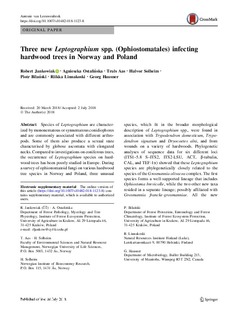| dc.description.abstract | Species of Leptographium are characterized by mononematous or synnematous conidiophores and are commonly associated with different arthropods. Some of them also produce a sexual state characterised by globose ascomata with elongated necks. Compared to investigations on coniferous trees, the occurrence of Leptographium species on hardwood trees has been poorly studied in Europe. During a survey of ophiostomatoid fungi on various hardwood tree species in Norway and Poland, three unusual species, which fit in the broader morphological description of Leptographium spp., were found in association with Trypodendron domesticum, Trypodendron signatum and Dryocoetes alni, and from wounds on a variety of hardwoods. Phylogenetic analyses of sequence data for six different loci (ITS1–5.8 S–ITS2, ITS2-LSU, ACT, b-tubulin, CAL, and TEF-1a) showed that these Leptographium species are phylogenetically closely related to the species of the Grosmannia olivacea complex. The first species forms a well-supported lineage that includes Ophiostoma brevicolle, while the two other new taxa resided in a separate lineage; possibly affiliated with Grosmannia francke-grosmanniae. All the new species produce perithecia with necks terminating in ostiolar hyphae and orange-section shaped ascospores with cucullate, gelatinous sheaths. These species also produce dark olivaceous mononematous asexual states in culture. In addition, two of the newly described species have a second type of conidiophore with a short and non-pigmented stipe. The new Leptographium species can be easily distinguished from each other by their appearance and growth in culture. Based on novel morphological characters and distinct DNA sequences, these fungi were recognised as new taxa for which the names Leptographium tardum sp. nov., Leptographium vulnerum sp. nov., and Leptographium flavum sp. nov. are provided. | |

